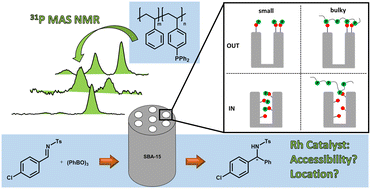Determination of accessibility and spatial distribution of chiral Rh diene complexes immobilized on SBA-15 via phosphine-based solid-state NMR probe molecules†
Abstract
In molecular heterogeneous catalysis knowledge about the location and accessibility of the immobilized metal complex inside porous solids is important to assess the catalytic efficiency. Here, we developed a method to quantify accessible Rh complexes in SBA-15 mesopores via solid state NMR spectroscopy. In order to identify suitable probe molecules several phosphines were screened in solution and their diameters were determined by DFT calculations. The ligation of phosphines at immobilized Rh complexes was then monitored by quantitative 31P MAS NMR spectroscopy. For the first time a polymer too large to enter the mesopores, poly(styrene-co-vinyltriphenylphosphine), PS-co-PVPP, was used to probe selectively Rh complexes immobilized on the external surface, in pore mouths or defects. By combining 31P MAS NMR and ICP-OES the P/Rh ratio was determined revealing that only up to 39% of the immobilized Rh complexes were accessible. Therefore, corrected turnover numbers (TONs) of up to 55 could be calculated for the asymmetric 1,2-addition with immobilized Rh catalysts. With the herein presented methodology the accessibility and spatial distribution of immobilized molecular catalysts can for the first time be evaluated quantitatively.



 Please wait while we load your content...
Please wait while we load your content...